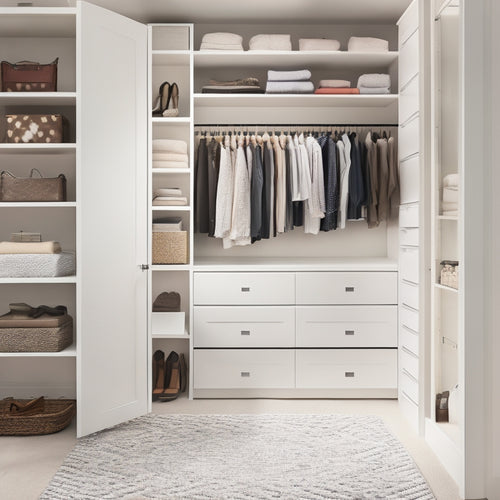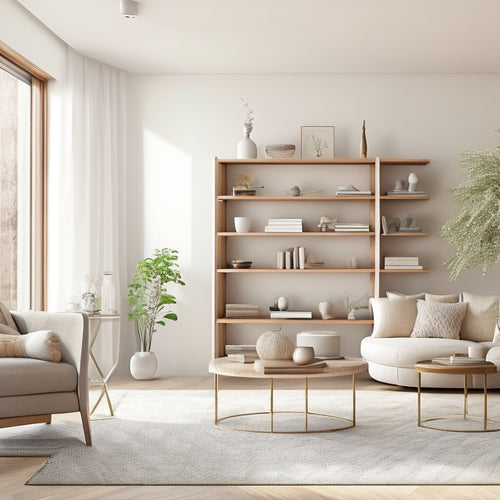
Organize Cookbooks in Small Spaces
Share
To organize your cookbook collection in a small space, start by maximizing vertical shelf space with adjustable shelves, shelf dividers, and wall-mounted racks. Employ hidden storage areas like the space above kitchen cabinets, repurposed old cabinets, or underutilized nooks. Optimize cookbook stackability with sturdy shelves, decorative options like floating shelves, and multi-functional shelves that provide additional storage or workspace. Designate a specific cookbook zone, categorize by type, and consider a rotating bookcase to maximize storage. By implementing these strategies, you'll be well on your way to a clutter-free kitchen - and there's even more you can do to get the most out of your cookbook collection.
Key Takeaways
- Maximize vertical shelf space by using shelf dividers, wall-mounted racks, and ladder shelving to store cookbooks efficiently.
- Utilize hidden storage areas like above kitchen cabinets, repurposed old cabinets, and underutilized nooks to store cookbooks.
- Implement a rotating bookcase in corners to utilize wasted space and provide easy access to cookbooks.
- Designate a specific cookbook zone in the kitchen and organize cookbooks by category, such as cuisine type or meal type, for optimized layout.
- Consider transitioning to digital cookbooks or using digital alternatives like e-cookbooks, cooking apps, and recipe organization apps to reduce physical storage needs.
Maximize Vertical Shelf Space
When it comes to maximizing vertical shelf space, cookbook enthusiasts with small kitchens or apartments often face a formidable challenge. You can overcome this by implementing strategic storage solutions, such as adopting a one in, one out policy to prevent new clutter accumulation streamlining personal belongings.
Start by using shelf dividers or decorative boxes to separate cookbooks and keep them organized. Consider installing adjustable shelves or vertical bins to optimize storage capacity. Wall-mounted racks and ladder shelving can also provide additional space for storing cookbooks.
Don't forget to employ bookends to keep books upright and prevent them from toppling over. Implementing container organization and employing hanging organizers or magazine holders can also help keep your cookbook collection tidy and easily accessible.
Utilize Hidden Storage Areas
You've optimized your shelf space, but there are still more opportunities to stash your cookbooks in clever spots.
Look for hidden compartments or underutilized nooks in your kitchen where you can store your cookbooks. For instance, consider the space above your kitchen cabinets or the area behind a decorative wall panel.
You can also repurpose an old cabinet or drawer to create a secret storage spot. Measure the space and choose cookbooks that fit snugly, or use baskets or bins to corral smaller volumes.
Optimize Cookbook Stackability
You'll want to maximize your cookbook storage by optimizing stackability.
To do this, consider vertical storage tips, such as using stackable shelves or bookcases, to make the most of your wall space.
Vertical Storage Tips
Maximize your cookbook storage by thinking vertically. You can install shelves with sturdy materials like wood, metal, or glass to hold your cookbooks.
Consider decorative options like floating shelves or ladder bookcases to add visual appeal. When choosing shelf materials, verify they can support the weight of your cookbooks.
Measure your space carefully to select the right size and number of shelves. You can also use wall-mounted book racks or foldable bookshelves that can be easily moved or rearranged as needed.
Stacking Cookbook Styles
Five essential stacking styles can help optimize cookbook stackability in small spaces.
You can use the horizontal stacking method, where books are placed flat on top of each other, making it easy to identify the top book.
Alternatively, you can use the vertical stacking method, where books are stacked upright, taking advantage of height.
For a more organized approach, try color coding, where books are arranged by cover color, creating a visually appealing display.
Genre sorting is another option, where books are grouped by type, such as baking or international cuisine.
Designate a Cookbook Zone
You'll want to identify a specific area in your kitchen or nearby space to serve as your cookbook zone, considering factors like accessibility and proximity to your cooking station.
This zone will require space-saving shelves or storage units that can accommodate your cookbook collection without taking over the room.
Zone Location Options
By dedicating a specific area to your cookbook collection, you'll create a functional and organized space that makes cooking and meal planning a breeze.
When deciding on a zone location, consider the kitchen's high-traffic areas, such as near the cooking station or by the meal planning desk. Place your cookbooks within easy reach to save time and effort.
Consider categorizing your cookbooks by type, such as baking, international, or special diets, to optimize your zone's layout. Measure the shelf dimensions to guarantee a snug fit and maximize storage.
Space-Saving Shelves Needed
In the heart of your kitchen, a dedicated zone for cookbooks awaits, and it's essential to equip it with space-saving shelves that can efficiently store your collection. You'll want shelves that are functional, yet visually appealing to maintain a sense of calm in your cooking space.
| Shelf Materials | Decorative Accents | Space-Saving Features |
|---|---|---|
| Wood | Carved trim | Foldable design |
| Metal | Industrial-style pipes | Adjustable height |
| Glass | LED lighting | Compact, wall-mounted |
| Recycled materials | Rustic wooden brackets | Sliding doors |
| Composite materials | Minimalist, sleek handles | Stackable units |
When choosing your shelves, consider the materials, decorative accents, and space-saving features that fit your kitchen's style and your cookbook collection's needs.
Cookbook Storage Ideas
Designate a specific area in your kitchen as your cookbook zone, where you can easily access and browse through your collection without cluttering the countertops.
Organize your cookbooks into categories, such as baking, international cuisine, or quick meals, to make it easier to find the one you need.
Consider employing decorative displays, like a wooden cookbook stand or a cookbook carousel, to add visual appeal to your zone.
You can also make use of vertical space by installing a cookbook ladder or a hanging cookbook rack.
Select Multi-Functional Shelves
Your compact kitchen or dining area can greatly benefit from multi-functional shelves that serve purposes beyond just holding cookbooks. These shelves can provide additional storage, display decorative items, or even serve as a workspace. When selecting a multi-functional shelf, consider the materials and design aesthetics that fit your space.
| Shelf Materials | Design Aesthetics | Benefits |
|---|---|---|
| Wood | Traditional, Rustic | Warm, natural look |
| Metal | Modern, Industrial | Sleek, easy to clean |
| Glass | Contemporary, Minimalist | Reflects light, visually appealing |
| Hybrid | Adaptive, Eclectic | Combines styles, unique look |
| Recycled | Eco-Friendly, Bohemian | Environmentally conscious, eclectic vibe |
Choose a shelf that complements your existing decor and meets your functional needs. By doing so, you'll create a harmonious and efficient space that makes the most of your small area.
Implement a Rotating Bookcase
Compact spaces require clever solutions, and a rotating bookcase is an excellent way to maximize storage while keeping your cookbooks within easy reach.
You can install a rotating bookcase in a corner, making the most of the often-wasted space. Consider the bookcase placement carefully, ensuring it's accessible and visible.
A rotating design allows you to store more cookbooks in a smaller footprint, making it ideal for small kitchens or apartments.
When choosing a rotating bookcase, look for one with adjustable shelves to accommodate cookbooks of different sizes. Additionally, consider a bookcase with a lock to keep your cookbooks from falling off the shelves when you rotate it.
Embrace a Digital Cookbook
Kick your cookbook collection into the technological era by embracing a digital cookbook. This switch offers several digital cookbook benefits, including reduced physical storage space and easy access to your favorite recipes.
You can store thousands of cookbooks digitally, without sacrificing an inch of shelf space. With recipe organization apps like Paprika Recipe Manager or BigOven, you can categorize, tag, and search your digital cookbooks with ease.
Plus, you can add notes, ratings, and photos to each recipe, making it easier to refine your cooking skills. By going digital, you'll have more control over your cookbook collection and be able to focus on what really matters – cooking up a storm in your small kitchen!
Frequently Asked Questions
How Do I Organize Cookbooks With Different Sizes and Shapes?
You'll need to get creative with arrangements to maximize space. Try vertical stacking with larger books on the bottom and smaller ones on top, or use bookends to keep them upright and organized.
Can I Store Cookbooks in a Humid Kitchen Environment?
You can store cookbooks in a humid kitchen, but take precautions to prevent moisture damage: use acid-free paper bookmarks, store books upright, and consider waterproofing or varnishing shelves to minimize humidity effects and guarantee cookbook preservation.
Are Cookbook Storage Boxes a Good Alternative to Shelves?
When you're a bookworm, storage is like finding a perfect recipe - it needs to balance form and function. You'll find cookbook storage boxes a great alternative to shelves, offering easy accessibility while keeping your kitchen's aesthetic intact, and your books protected from dust and damage.
How Often Should I Clean and Dust My Cookbooks?
You should clean your cookbooks every 2-3 months, dusting their tops and spines gently with a soft-bristled brush, and wiping covers with a damp cloth to maintain their condition and prevent damage from dust accumulation.
Can I Store Cookbooks Near a Heat Source Like an Oven?
Don't let your cookbook collection become a sacrificial lamb on the altar of convenience; keep them away from heat sources like ovens, as they can suffer heat damage, compromising their safety and your culinary sanity.
Related Posts
-

Designing Custom Shelving for Closet Organization Success
When designing custom shelving for closet organization success, you'll need to assess your closet's unique dimensions...
-

10 Space-Saving Secrets for Cluttered Homes
You can banish clutter and breathe easy again by optimizing your home's vertical space with wall-mounted racks and sh...
-

7 Best Corner Shelving Units for Home
You're looking to optimize your home's corner spaces with stylish and functional shelving units. Corner shelves are a...


